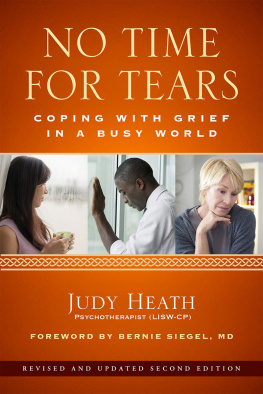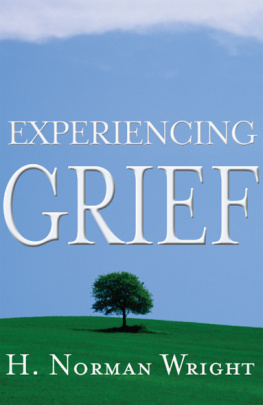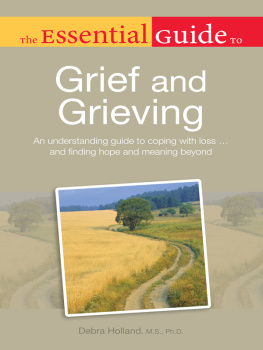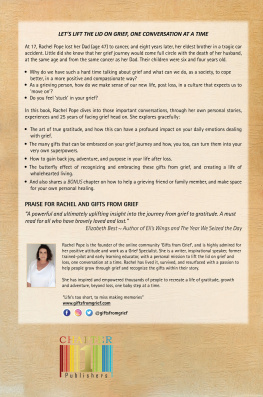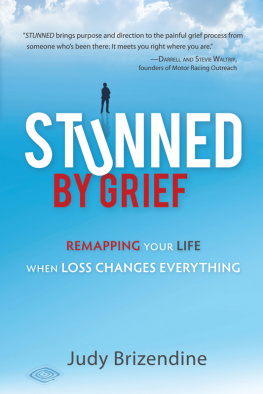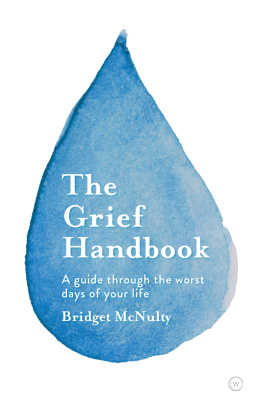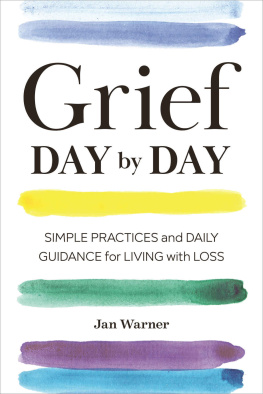Copyright 2015 by Judy Heath
Foreword copyright 2015 by Bernie Siegel
All rights reserved
Published by Chicago Review Press Incorporated
814 North Franklin Street
Chicago, Illinois 60610
ISBN 978-1-61373-164-2
Library of Congress Cataloging-in-Publication Data
Heath, Judy.
No time for tears : coping with grief in a busy world / Judy Heath ; foreword by Bernie Siegel. Revised and updated second edition.
pages cm
Summary: NO TIME FOR TEARS is a guide to help not only people struggling through grief due to the loss of a loved one but also those who counsel them. Psychotherapist Judy Heath offers practical and useful ways to traverse the pitfalls that may lead to unresolved and lasting grief and to find comfort and peace. Those who counsel the bereaved will find new ways to inspire their practices and many tools to assist those in need. This second edition includes updated information about medication and grief, children and grief, coping after a loved one is murdered, and lessons learned in treating survivors and victims loved ones after 9/11 Provided by publisher.
Includes bibliographical references and index.
ISBN 978-1-61373-164-2 (paperback)
1. Grief therapy. 2. Grief. I. Title.
RC455.4.L67H43 2015
155.937dc23
2015002289
Cover design: Marc Whitaker / MTWdesign.net
Cover photos: Shutterstock.com
Interior design: Sarah Olson
Printed in the United States of America
5 4 3 2 1
DEDICATED TO
THOMAS
CARLL, ABBY, AND BRITTANY
CONTENTS

Index
FOREWORD

And we ourselves shall be loved for a while and forgotten. But the love will have been enough; all those impulses of love return to the love that made them. Even memory is not necessary for love. There is a land of the living and a land of the dead and the bridge is love, the only survival, the only meaning. Thornton Wilder
Try to remember that a good man can never die. You will feel him in all things that are here out of love, and for love. The best part of a good man stays. It stays forever. Love is immortal and makes all things immortal. But hate dies every minute. William Saroyan

I couldnt agree with Judy Heath more about our society leaving no time for tears. When we see people crying we are more apt to hand them a tissue and tell them everything will be all right than to deal with their grief and allow them to experience it. I see the difference in our cancer support groups, where grief and tears are not something terrible but are viewed rather as a natural act related to lifes difficulties.
I also know that endless grief serves no purpose, so our society needs to learn how to accept and experience grief but not let it take over our lives. This is something I think many people fear and, therefore, deny their grief. In a book I have written, Buddys Candle, I deal with this issue. Let me summarize it by saying if we never stop crying we extinguish our beloveds celestial candle. Would our departed loved one want us to enjoy the day or grieve endlessly? So therapists, doctors, families, and those who realize and accept their mortality need to feel free to express feelings and shed tears. Just as moisture softens a hard, dry sponge, so tears help to heal our wounds. When the grieving is done we can then resume our lives with a new understanding that loss is our teacher and not something to be denied.
The reason many people feel abandoned by doctors when their loved ones die is because doctors are often not taught how to care for people and deal with loss. Doctors tend to think rather than feel. In a study at Yale in which surgeons were asked how it felt to be a surgeon, they answered, I think (it is like such and such), rather than I feel Famous paintings depict dying adults and children with the doctor sitting by the bedside with chin in hand, thinking.
Because of the pain I experienced as a physician and had no chance to express in a medical environment, I have written to the dean of my medical school several times saying the instructors taught me to be an excellent surgeon, but they did not teach me how to deal with my feelings and care for my patients. No one answered my letters. The American College of Surgeons Pledge says, I will deal with my patients as I would wish to be dealt with. I cannot get them to change the words deal with to care for.
Doctors see death as a failure and rarely even use the term when a patient dies. Families see death as their loved one losing a battle, and so they empower the disease by focusing on the enemy and make their family member feel guilty for being a loser. Most patients die in the hospital at night when the doctors are not there to interfere with the process and their family is absent so they do not feel guilty for leaving.
Remember we have a great deal to say about when we die. So do not feel guilty if your beloved dies when you are not present. I have seen this with my parents, patients, and even family pets. My father had no problem sharing his last minutes with our family, while I knew my mother and some others would not die when their loved ones were in the room with them.
What we need to be taught is how to help people to live between office visits and die when they are ready to leave their bodies. I have found when people have support and love, dying is not as hard to do. My father died laughing with his family by his side listening to stories about his life. We left his hospital room with no fear of death and free to express our sadness but with no guilt about feeling joyful.
We also forget that if we attend funerals and are present when someone dies we can be healed by the family who appreciates our care and love. I know from experience. When we focus on avoiding death our lives become doomed to failure. I always recommend the movie Harold and Maude as therapy. In it, Ruth Gordon plays an eighty-year-old who is into life and meets a young man who is into death. At one point the young actor says, I decided I enjoyed being dead. His mother gives him a car as a gift and he turns it into a hearse. The last scene shows the young mans hearse going over a cliff after the character played by Ruth Gordon dies. You assume he has committed suicide, but then the camera shows him walking away playing his banjo. I realized what he did was eliminate death as the focus of his life. He could grieve over his loss, but now he was truly alive and not denying his mortality.
Woody Allen writes about two guys talking, one of whom is in great despair about life. His friend asks him, What are you doing Saturday night?
Committing suicide.
What about Friday night?
It may seem strange to talk about how to handle loss and the death of loved ones by saying that death, for me, is not the worst outcome. There is a point in everyones life, no matter ones species, when ones body no longer will function and is not a comfortable place to be in. I see this in the actions of people and pets I have loved and cared for.
Symbolically, when people draw purple balloons, butterflies, and kites going up into the sky they are telling me, often unconsciously, that they are ready for the healing that comes when they make the spiritual transition and leave their bodies. Death is about beginnings and not endings. We do not call graduations
Next page
